Wittenberg
Wittenberg (/ˈwɪtənbɜːrɡ, ˈvɪt-/ WIT-ən-burg, VIT-, German: [ˈvɪtn̩bɛʁk]), officially Lutherstadt Wittenberg, is the fourth largest town in Saxony-Anhalt, Germany. Wittenberg is situated on the River Elbe, 60 kilometers (37 mi) north of Leipzig and 90 kilometers (56 mi) south-west of Berlin, and has a population of 46.008 (2018).
Wittenberg Lutherstadt Wittenberg | |
|---|---|
   From top: Skyline of Wittenberg, Wittenberg old town with view to the Castle church (undergoing repairs), Market square with town hall and Stadtkirche Wittenberg, inside Wittenberg castle church and Leucorea university | |
 Coat of arms | |
Location of Wittenberg within Wittenberg district 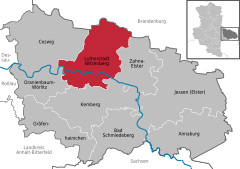  | |
 Wittenberg 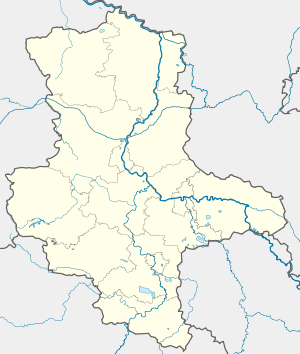 Wittenberg | |
| Coordinates: 51.8671°N 12.6484°E | |
| Country | Germany |
| State | Saxony-Anhalt |
| District | Wittenberg |
| Government | |
| • Mayor | Eckhard Naumann (SPD) |
| Area | |
| • Total | 240.32 km2 (92.79 sq mi) |
| Elevation | 67 m (220 ft) |
| Population (2018-12-31)[1] | |
| • Total | 46,008 |
| • Density | 190/km2 (500/sq mi) |
| Time zone | CET/CEST (UTC+1/+2) |
| Postal codes | 06886 |
| Dialling codes | 03491 |
| Vehicle registration | WB |
| Website | wittenberg.de |
Wittenberg is famous for its close connection with Martin Luther and the Protestant Reformation, for which it received the honorific Lutherstadt. Several of Wittenberg's buildings associated with the events, including a preserved part of the Augustinian monastery in which Luther lived, first as a monk and later as owner with his wife Katharina von Bora and family, considered to be the world's premier museum dedicated to Luther. Wittenberg was also the seat of the Elector of Saxony, a dignity held by the dukes of Saxe-Wittenberg, making it one of the most powerful cities in the Holy Roman Empire.
Today, Wittenberg is an industrial center and popular tourist destination, best known for its intact historic center and various memorial sites dedicated to Martin Luther and Philip Melanchthon. The Luther Memorial was added to the UNESCO world heritage list in 1996.
History
![]()
![]()
![]()
![]()
![]()
![]()
![]()
![]()
![]()
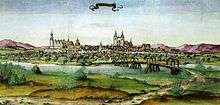

Historical documents first mention the settlement in 1180 as a small village founded by Flemish colonists under the rule of the House of Ascania. In 1260 this village became the residence of the dukes of Saxe-Wittenberg, and in 1293 the settlement was granted its town charter as a free-standing town.
Wittenberg developed into an important trade centre during the following several centuries, because of its central location. When the local branch of the Ascanians died out in 1422, control of Saxe-Wittenberg passed to the House of Wettin. This town became an important regional political and cultural centre at the end of the 15th Century, when Frederick III "the Wise", the Elector of Saxony from 1486 to 1525, made his residence in Wittenberg. Several parts of boundaries of the town were extended soon afterward. The second bridge over the Elbe River was built from 1486 through 1490 and the castle church (the Schlosskirche in German) was erected from 1496 through 1506. The Elector's palace was rebuilt at the same time.
In 1502 Elector Frederick founded the University of Wittenberg, which attracted some important thinkers, such as Martin Luther—a professor of theology beginning in 1508—and Philipp Melanchthon—a professor of Greek starting in 1518.
On 31 October 1517, according to legend, Luther nailed his 95 theses against the selling of indulgences at the door of the All Saints', the Castle Church – an event taken as marking the beginning of the Protestant Reformation. The Anabaptist movement had one of its earliest homes in Wittenberg, when the Zwickau prophets moved there in late 1521, only to be suppressed by Luther when he returned from the Wartburg in spring 1522. The Capitulation of Wittenberg (1547) is the name given to the treaty by which John Frederick the Magnanimous was compelled to resign the electoral dignity and most of his territory to the Albertine branch of the House of Wettin.
In 1760, during the Seven Years' War, the Austrians bombarded the Prussian-occupied town. The French took control in 1806, and Napoleon commanded the refortification of the town in 1813. In 1814 the Prussian Army under Tauentzien stormed Wittenberg; he received the title of "von Wittenberg" as a reward. In 1815 Wittenberg became part of Prussia, administered within the Province of Saxony. Wittenberg continued to be a fortress of the third class until the reorganisation of German defences after the foundation of the new German Empire led to its dismantling in 1873.
It contained a prisoner of war camp from 1914 to 1918. A camp 10½ acres in area was set up at Klein Wittenberg, 2 miles from the city. Eight compounds held 13,000 men. During the typhus epidemic of 1914-1915, conditions were harsh. The camp medical officer, Dr. Aschenbach, was awarded the Iron Cross for his part in the epidemic. The award was questioned by the Allies. The use of dogs to attack POW’s was criticised by American Ambassador James W. Gerard in his book “Four Years in Germany”.
Unlike many other historic German cities during World War II, Wittenberg's town centre was spared destruction during the conflict. The Allies agreed not to bomb Wittenberg, though fighting took place in the town, with bullet pock-marks visible on the statues of Luther and Melanchthon at the market square – or so the popular version of the town's history goes. In actuality, the Luther statue was not even present in the town square during much of the war, but in storage at Luther Brunnen, a roadhouse a few kilometres north of the town.
Wittenberg's reputation as a town protected from Allied bombing is largely accurate. However, just outside Wittenberg the government had built the Arado Flugzeugwerke (the Arado Aircraft Factory), which produced components of airplanes for the Luftwaffe. This war factory was worked by Jews, Russians, Poles, political prisoners and even a few Americans—all prisoners engaging in forced labour, including POW’s who were supposed to be exempt from this sort of labor. American and British planes bombed the factory near the end of the war, and in destroying it killed over one thousand of the prisoners and POW’s placed by the Germans in this war plant. The 1995 publication of "...und morgen war Krieg!" by Renate Gruber-Lieblich[2] attempts to document this tragic bombing outside Wittenberg.
At the end of the war, Soviet forces occupied Wittenberg; it became part of East Germany in 1949. During the East German period, it formed part of Halle District. By means of the peaceful revolution in 1989, the communist régime dissolved and the town has been governed democratically since 1990.
Wittenberg is currently characterized by renovation and new construction work, an economic recovery and tourism development as a "place of pilgrimage for the Reformation". With the Luther Decade, the city has been preparing for the 500th anniversary of the Reformation since 2008, which took place in 2017. Numerous buildings have been restored, the infrastructure has been partially renewed and numerous new attractions have been created in the city (e.g. the new Lutherstadt Wittenberg Hauptbahnhof, Arsenal shopping centre, Luthergarden or the Panometer) .
In 2014 Lutherstadt Wittenberg was awarded the honorary title European City of the Reformation by the Community of Protestant Churches in Europe.
| UNESCO World Heritage Site | |
|---|---|
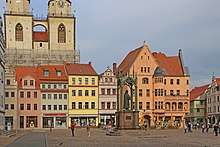 Market square with Stadtkirche Wittenberg | |
| Part of | Luther Memorials in Eisleben and Wittenberg |
| Includes | Lutherhaus, Melanchthonhaus, Stadtkirche Wittenberg and All Saints' Church, Wittenberg |
| Criteria | Cultural: iv, vi |
| Reference | 783 |
| Inscription | 1996 (20th session) |
Historical population
The figures are given for the metropolitan district at the point in time. Up to 1791 the figures are generally estimated, later figures are from census or local authorities.
|
|
|
from 2012 census.
Places added to Wittenberg
Main sights
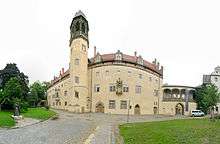

Wittenberg is home to numerous historical sites, as well as portraits and other paintings by Lucas Cranach the Elder and Younger. On the doors of All Saints' Church, the Schlosskirche ("castle church", built in 1496–1506) Martin Luther is said to have nailed his 95 theses in 1517. It was seriously damaged by fire in 1760 during a bombardment by the French during the Seven Years' War, was practically rebuilt, and was later (1885–1892) restored. The wooden doors, burnt in 1760, were replaced in 1858 by bronze doors, bearing the Latin text of the theses. Inside the church are the tombs of Martin Luther, Philipp Melanchthon, Johannes Bugenhagen, Paul Eber and of the electors Frederick the Wise (by Peter Vischer the Younger, 1527) and John the Constant (by Hans Vischer), and portraits of the reformers by Lucas Cranach the Younger, who is also buried in the church.
St. Mary's Church, the parish church in which Luther often preached, was built in the 14th century, but has been much altered since Luther's time. It contains a painting by Lucas Cranach the Elder, representing the Last Supper (with the faces of Luther and other reformers), Baptism and Confession, also a font by Hermann Vischer the Elder (1457). In addition, there are numerous historic paintings in the church.
The ancient electoral palace is another of the buildings that suffered severely in 1760; it now contains archives.
Martin Luther's home, the Lutherhaus, where he studied and lived both before and after the Reformation, is now a museum containing many artifacts from his life. Melanchthon's house and the house of Lucas Cranach the Elder, mayor of Wittenberg, can also be found here. Statues of Luther (by Schadow), Melanchthon and Bugenhagen embellish the town. The spot outside the Elster Gate where Luther publicly burned the papal bull in 1520 is marked by an oak tree.
The original Wittenberg University quadrangle also lies in the city centre.
Image gallery
- Wittenberg old town
_-_geo.hlipp.de_-_28216.jpg) View to Schlosskirche
View to Schlosskirche Replica of the Ninety-five Theses in the Schlosskirche, Wittenberg
Replica of the Ninety-five Theses in the Schlosskirche, Wittenberg

- The Augusteum and Lutherhaus
 Town Hall
Town Hall Hundertwasserschule, School by Friedensreich Hundertwasser
Hundertwasserschule, School by Friedensreich Hundertwasser Werksiedlung Wittenberg
Werksiedlung Wittenberg The Arsenal shopping centre, opened 2012
The Arsenal shopping centre, opened 2012 Font by Hermann Vischer the Elder, St Mary's Church, Wittenberg
Font by Hermann Vischer the Elder, St Mary's Church, Wittenberg_Philipp_Melanchthon.jpg) Philipp Melanchthon in the market square
Philipp Melanchthon in the market square Market square, with ancient town hall, statue of Martin Luther and Stadtkirche
Market square, with ancient town hall, statue of Martin Luther and Stadtkirche Hamlethaus at Wittenberg old town
Hamlethaus at Wittenberg old town Maarten Luther Statue, Wittenberg
Maarten Luther Statue, Wittenberg Town Hall, Wittenberg
Town Hall, Wittenberg Facade images, town hall, Wittenberg
Facade images, town hall, Wittenberg
Coat of arms
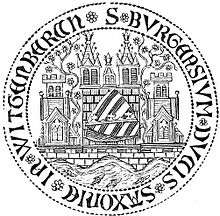
Wittenberg's civic coat of arms conveys with its various heraldic elements something of the town's history. On 27 June 1293, Wittenberg was granted town rights by Duke Albert II. There then arose a mediaeval town whose highest governing body was its council. This council, known to have existed as early as 1317, was given the job of administering the town in its care through law and legislation, and of handling the town's revenue. For documentation, the administration used its own seal. One version of what is believed to be the town's oldest town seal, which the council used, and which dated from the first half of the 14th century, set the pattern with its elements for various civic coats of arms down to the present day.
The coat of arms symbolizes, with its crenelated wall and the towers within and each side, a town that was already strongly fortified by 1409. The two shields in the centre form the coat of arms of the Electorate of Saxony with the Saxon arms on the right, whose gold and black stripes recall the Ascanian rulers' house colours with the Rautenkranz (literally "lozenge wreath", although it is no such thing, as can be seen at the Saxony article) across them symbolizing the town's founder Duke Albrecht II since 1262, when it appeared in his arms. The shield on the left is the Wittenberg district's arms. In 1356, Emperor Charles IV bestowed upon the Duke of Saxony-Wittenberg the honour of Elector. Wittenberg became an Electoral residence. The shield with its crossed swords stands for the office of "Arch-Marshal of the Holy Roman Empire" inextricably joined by the Electorate, brought to Wittenberg by Rudolf I. Both coats of arms continued to be used by the Wettins after the Ascanians died out. The flowing water at the foot of the shield symbolizes Wittenberg's location on the River Elbe. The fish is a salmon, which were once abundant in the Elbe. The fishermen, like all professions in town, got their own order in 1422, and the fish found its way onto their coat of arms.
Economy and infrastructure
The town is an important centre of chemical industry with the SKW Stickstoffwerke Piesteritz GmbH. The whole area of the industrial park covers more than 220 hectares with more than 1,500 workers. Wittenberg is also the headquarters of the eco-friendly web search engine Ecosia. Tourism plays a major role. Wittenberg is one of the top destinations in Saxony-Anhalt.
Lutherstadt Wittenberg station is the main railway station. It connects Wittenberg hourly with Berlin to the north and Leipzig and Halle (Saale) to the south. The station was rebuilt to be more environmentally friendly and re-opened in December 2016.
.jpg) The new Lutherstadt Wittenberg station in 2017
The new Lutherstadt Wittenberg station in 2017- The Elbe bridge is part of the Bundesstraße 2 federal highway
- The 'SKW Piesteritz' industrial area
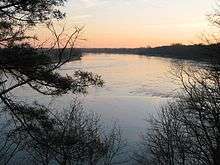
Theatre, culture and education

Wittenberg has a long tradition of cultural events. The Central German State Theatre (Mitteldeutsches Landestheater) reached a great importance in GDR times. Since 1996, the town has staged open-air theatre shows based on the Lutheran history still alive in many historical places of the ancient town. As highlights, in 2001 and 2005, Fernando Scarpa became the artistic director of the "Bühne Wittenberg" (Stage Wittenberg), a project for theatre, art and culture in the whole of Germany which attracts many visitors to the town and whose success is known European-wide. On 2002 and 2003 Stefano Vagnini, Italian composer and organist created the music for Thesys and Luther Stories. Prince Hamlet is said to have studied in Wittenberg and it was the supposed home of Dr. Faustus.
Wittenberg is seat of the Leucorea which is part of the Martin Luther University of Halle-Wittenberg, the largest university in Saxony-Anhalt.
The 20th century Expressionist artist Else Hertzer was born and raised in Wittenberg.[3]
International relations
Wittenberg is twinned with:[4]





References
- "Bevölkerung der Gemeinden – Stand: 31. Dezember 2018" (PDF). Statistisches Landesamt Sachsen-Anhalt (in German).
- Gruber-Lieblich, Renate (1995). "... und morgen war Krieg!": Arado Flugzeugwerke GmbH Wittenberg 1936 - 1945 ; ein KZ-Lager entsteht (in German). R. Gruber-Lieblich. ISBN 9783866343122. Retrieved 29 May 2016.
- Mathias Tietke: Wittenberg. The 99 Special Pages of the City, p. 59
- "Partnerstädte". wittenberg.de (in German). Wittenberg. Retrieved 26 November 2019.
Further reading
- John M. Jeep, ed. (2001). "Wittenberg". Medieval Germany: an Encyclopedia. Garland Publishing. ISBN 0-8240-7644-3.
External links
| Wikimedia Commons has media related to Wittenberg. |
| Wikivoyage has a travel guide for Wittenberg. |
- Luther Memorials in Eisleben and Wittenberg UNESCO Official Website
- Municipal website
- Wittenberg Photo Gallery
- Theatre of Wittenberg (in German)
- Theatre of Wittenberg (in German)
- Wittenberg POW camp, a contemporary account of life in the WWI camp.
- Info on the camp typhus epidemic in World War One
- Luther and the Chemicals Industry, a 2013 documentary in English by Deutsche Welle covering the history of the city
